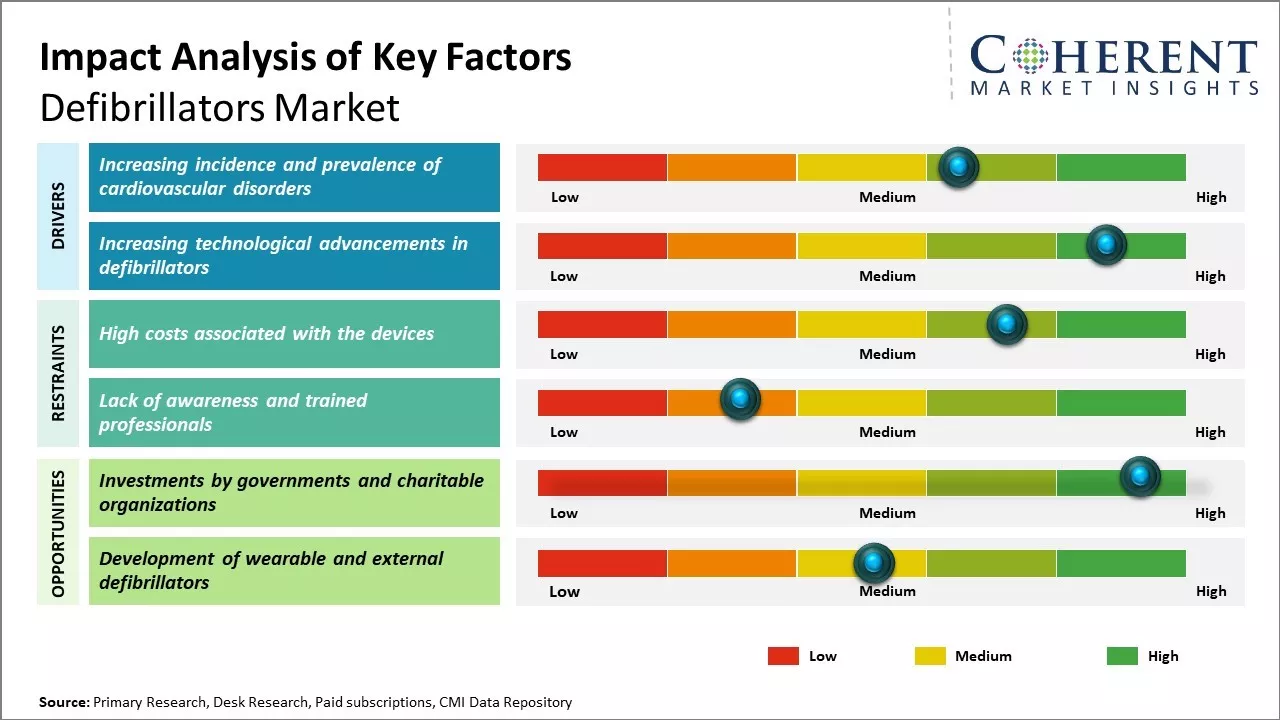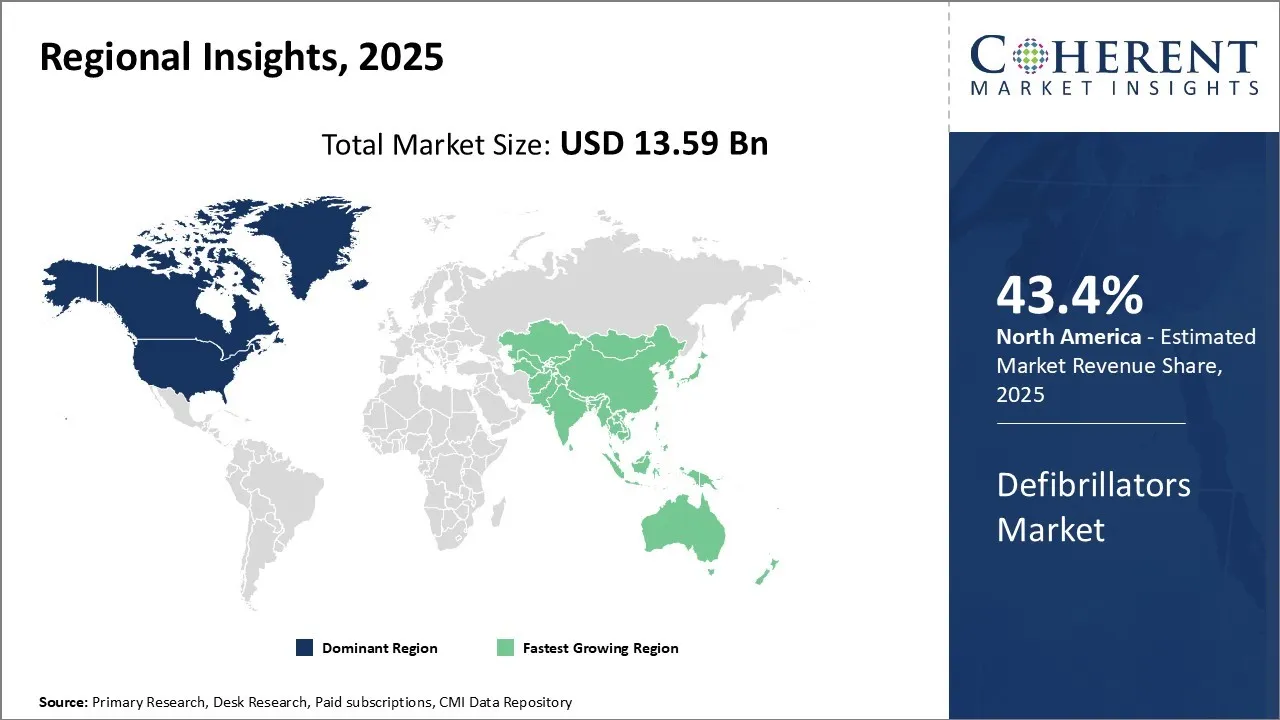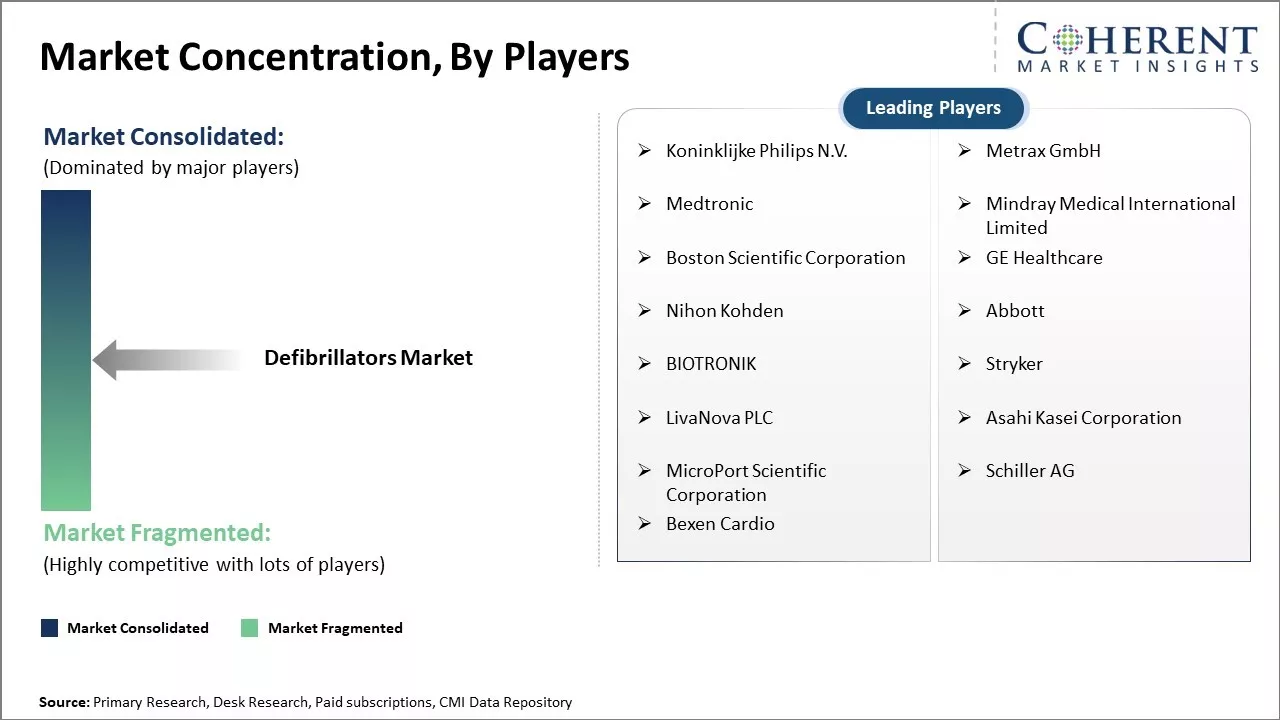The defibrillators market is estimated to be valued at USD 13.59 Bn in 2025 and is expected to reach USD 21.84 Bn by 2032, growing at a compound annual growth rate (CAGR) of 7.0% from 2025 to 2032.

To learn more about this report, Download Free Sample
The defibrillators market is expected to witness a positive growth trend over the forecast period. The rising prevalence of target diseases like cardiac arrest and sudden cardiac arrest is expected to be a key growth driver. Additionally, growing focus on providing public access defibrillators at public places is also anticipated to propel the demand for defibrillators globally. Other factors such as increasing adoption of external defibrillators over implantable defibrillators due to their non-invasive nature and higher acceptance among patients will further aid the market expansion.
|
Current Event |
Description and its Impact |
|
Aging Global Demographics and Rising Cardiovascular Disease Burden |
|
|
Artificial Intelligence and IoT Integration Revolution |
|
Uncover macros and micros vetted on 75+ parameters: Get instant access to report
Increasing incidence and prevalence of cardiovascular disorders in developed and emerging economies worldwide is expected to lead to a high demand for efficient defibrillator products during the forecast period.
For instance, according to World Health Organization, 17.9 million people die each year from cardio vascular disease, an estimated 32% of all deaths worldwide. Less than 75% of the cardiovascular disease deaths occur in low- and middle-income countries. 85% of all cardio vascular disease deaths are due to heart attacks and strokes.
Moreover, increasing patient population affected with cardiovascular disorder is expected to lead to a high demand for defibrillators over the forecast period. However, product recalls are expected to hinder the growth of the market during the forecast period.
Defibrillators have improved significantly in terms of cost, size reduction, and ease of operation. Two of the most important of these advancements are development of automated external defibrillator (AED) and implantable cardioverter defibrillator (ICD).
These devices help prevent cardiac attacks, with little or no external assistance irrespective of the time and location in case of any major variations in heartbeat. With technological improvements, operating a defibrillator has become easy for an observer post induction of proper training.
External defibrillators are anticipated to hold 62.3% of the market share in 2025. The external defibrillators segment dominates the global defibrillators market due to the growing incidence of sudden cardiac arrests occurring outside hospitals.
According to the American Heart Association, around 90% of cardiac arrests occur in homes or other non-hospital settings. External defibrillators are easy to use, light in weight, and portable devices that can be easily operated by laypeople to provide defibrillation therapy in emergency situations until professional medical help arrives.
Advancements in technology are further fueling the adoption of external defibrillators. Self-adhesive electrode pads and automated voice prompts make modern external defibrillators simple to operate with minimal training. The development of lightweight and compact devices has improved portability for public access use. Biphasic technology provides a higher success rate of cardioversion with less energy delivered.
Falling device prices are also supporting the procurement of external defibrillators for placement in offices, sports facilities, transportation hubs and other public areas. Overall, the ease of use, technological improvements and focus on improving out-of-hospital resuscitation are driving the growth of external defibrillators globally.
For instance, in February 2024, Gujarat school installs Automated External Defibrillators Machine at the Udgam Group of Schools in the premises of Udgam School.
The end user segment includes hospitals, homecare settings, public access settings, pre-hospital care settings, and others. Hospitals contribute the highest share of the defibrillators market and is projected to hold 56.8% of the market share in 2025.
Hospitals account for the largest share of the global defibrillators market owing to the high volume of defibrillator procedures performed in hospitals settings. A defibrillator is an integral part of emergency response technology in modern hospitals for managing life-threatening cardiac conditions like ventricular fibrillation and pulseless ventricular tachycardia.
Defibrillators are regularly used in intensive care units, cardiac catheterization labs, cardiac surgery suites, and emergency rooms where the monitoring and treatment of arrhythmias is frequently needed. Rising healthcare spending on quality of care and new hospital infrastructure development in developing countries is also driving the hospitals segment growth. Stringent guidelines regarding defibrillator availability in all hospital departments and areas further boost hospital procurement.
For instance, in September 2022, Kauvery Hospital launched Restart Heart Foundation, an initiative to address the rising numbers of cardiac arrests, educate the community on prevention of cardiac arrests and equip them with the skills to provide immediate response during emergencies. Through this foundation, Automated External Defibrillators (AED) have been installed at Semmozhi Poonga, Tidel Park and Vivekandhar Illam. (Ice House). Such initiatives are accelerating the defribrillators market demand.

To learn more about this report, Download Free Sample
North America has been the largest and most dominant regional market for defibrillators globally and is anticipated to hold 43.4% of the market share in 2025. The region enjoys a strong presence of major industry players with huge investments in R&D and manufacturing facilities. Most of the world's top defibrillator companies such as Medtronic, Boston Scientific, and Abbott Laboratories are headquartered in the U.S., giving them a major competitive advantage.
With an advanced healthcare infrastructure and higher healthcare spending, there is considerable demand for premium and technologically-advanced defibrillator devices in the region. The costs of devices in North America are also generally higher compared to other regions due to strong Intellectual property (IP) protection and brand premiumization strategies of players.
The Asia Pacific region, especially China and India, has emerged as the fastest growing regional market for defibrillators in recent years. Rising medical needs due to large populations and improving economic conditions are driving heavier investments in healthcare infrastructure and services across developing nations. This has boosted the demand for defibrillators across hospitals, public access points, and community centers.
At the same time, the region is witnessing steady growth in medical device manufacturing with emerging multinational players setting up production bases to cater to the local and export markets.
The low production costs have made Asia Pacific an attractive sourcing destination for defibrillator devices globally and boosted its exports. However, due to minimal IP protection and price sensitive end users in some nations, the average selling prices of devices is relatively lower compared to developed markets.
For instance, in March 2025, Medtronic Japan Co., Ltd. announced that the Aurora EV-ICDTM MRI device and the Epsila EVTM MRI Lead, which are used in the treatment of ventricular arrhythmias, launched successively in Japan.
In China, there is increasing government emphasis on deploying automated external defibrillators (AEDs) in public spaces with high foot traffic—such as transport hubs, schools, cultural/educational venues, and regions with aging populations.
For instance, in October 2024, the PLATINIUM™ implantable cardioverter defibrillators (ICD),manufactured by MicroPort® CRM Shanghai(MicroPort Soaring CRM (Shanghai) Co., Ltd.) an associated company of MicroPort® CRM, received approval from China’s National Medical Products Administration (NMPA).
In the UK, the defibrillator market is increasingly about accessibility, public awareness, and equity rather than just device sales. Efforts are underway to pass legislation mandating defibrillators in schools and sports/government buildings, along with required training for staff.
For instance, in November 2023, BHF launched free defibrillator scheme to save lives in communities across the UK.

To learn more about this report, Download Free Sample
| Report Coverage | Details | ||
|---|---|---|---|
| Base Year: | 2024 | Market Size in 2025: | USD 13.59 Bn |
| Historical Data for: | 2020 To 2024 | Forecast Period: | 2025 To 2032 |
| Forecast Period 2025 to 2032 CAGR: | 7.0% | 2032 Value Projection: | USD 21.84 Bn |
| Geographies covered: |
|
||
| Segments covered: |
|
||
| Companies covered: |
Koninklijke Philips N.V., Metrax GmbH, Medtronic, Mindray Medical International Limited, Boston Scientific Corporation, GE Healthcare, Nihon Kohden, Abbott, BIOTRONIK, Stryker, LivaNova PLC, Asahi Kasei Corporation, MicroPort Scientific Corporation, Schiller AG, Bexen Cardio |
||
| Growth Drivers: |
|
||
| Restraints & Challenges: |
|
||
Uncover macros and micros vetted on 75+ parameters: Get instant access to report
Rising prevalence of target diseases like sudden cardiac arrest and cardiovascular disorders drives demand. Favorable regulatory environment promoting public-access defibrillators also augurs well. Technological advancements enabling miniaturization and portability widen the target base. Investments by governments and charitable organizations to install more devices create a conducive environment.
*Definition: The defibrillators market involves the various tools, equipment, media, and reagents used to propagate and grow eukaryotic and prokaryotic cells outside of their natural environment. Cells are maintained and grown in carefully controlled sterile laboratory conditions for scientific research, biomanufacturing of biologics and vaccines, toxicology testing, and clinical cell therapy applications. Key products in this multibillion-dollar market include defibrillators media, sera, reagents, bioreactors, incubators, centrifuges, and microscopes.
Share
Share
About Author
Komal Dighe is a Management Consultant with over 8 years of experience in market research and consulting. She excels in managing and delivering high-quality insights and solutions in Health-tech Consulting reports. Her expertise encompasses conducting both primary and secondary research, effectively addressing client requirements, and excelling in market estimation and forecast. Her comprehensive approach ensures that clients receive thorough and accurate analyses, enabling them to make informed decisions and capitalize on market opportunities.
Missing comfort of reading report in your local language? Find your preferred language :
Transform your Strategy with Exclusive Trending Reports :
Frequently Asked Questions
Joining thousands of companies around the world committed to making the Excellent Business Solutions.
View All Our Clients